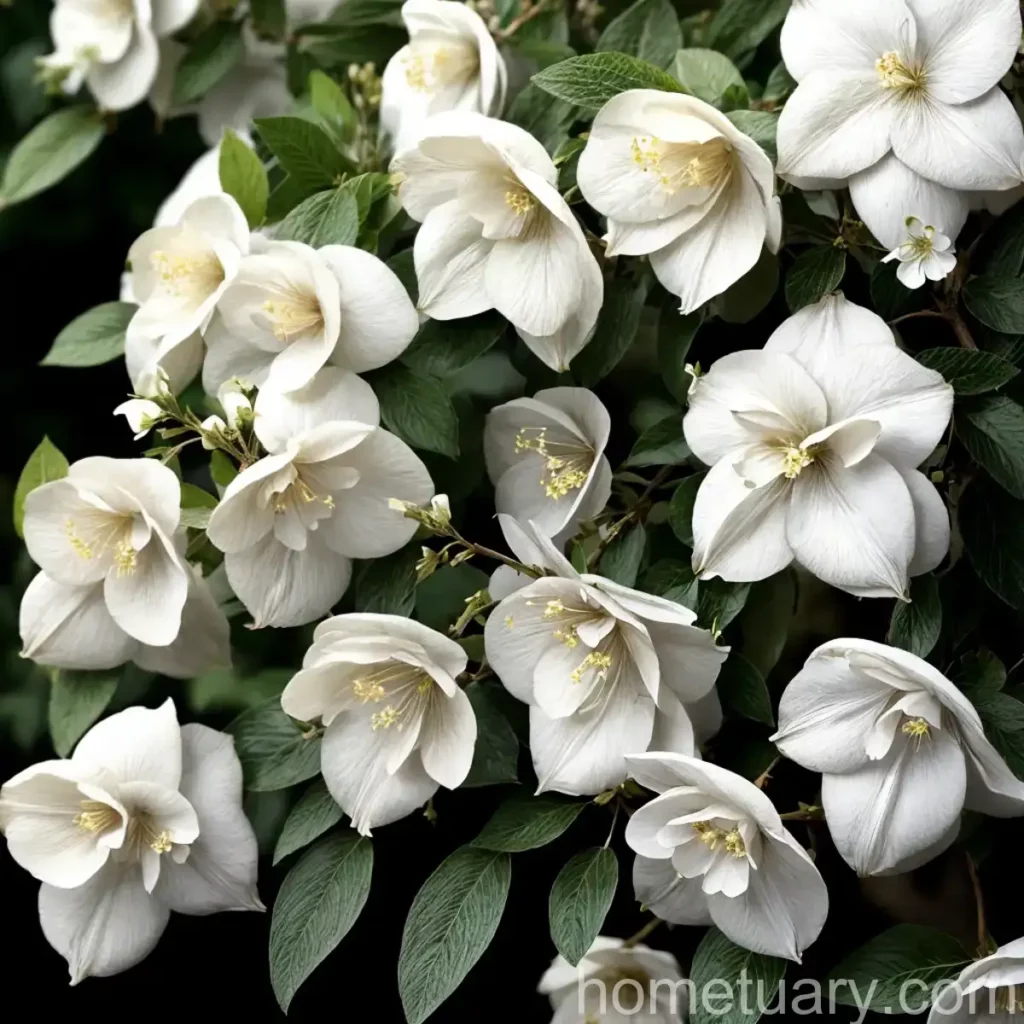All About Mock Orange (Philadelphus x lemoinei ‘Silver Showers’)
What is Plant: Mock Orange (Philadelphus x lemoinei ‘Silver Showers’)?
The mock orange (Philadelphus x lemoinei ‘Silver Showers’) is a stunning flowering shrub known for its fragrant white blossoms and graceful arching branches. The plant is a hybrid resulting from crossing different species of Philadelphus, a genus of about 60 species of shrubs in the family Hydrangeaceae. Mock orange is known for its delightful citrus fragrance, similar to that of orange blossoms, hence the common name. The ‘Silver Showers’ variety specifically is cherished for its elegant appearance and prolific blooming, making it a popular choice for gardens and landscaping.
Key Takeaways – Mock Orange (Philadelphus x lemoinei ‘Silver Showers’)
- Scientific Name: Philadelphus x lemoinei ‘Silver Showers’
- Common Names: Mock Orange, Silver Showers Philadelphus
- Type: Deciduous flowering shrub
- Notable Features: Fragrant white flowers, arching branches
- Usage: Gardens, landscaping, ornamental hedging
- Hardiness Zones: 4-8
- Mature Height: 6-8 feet
- Mature Spread: 6-8 feet
- Bloom Time: Late spring to early summer
Now, let’s delve into the specifics of cultivating and caring for this beautiful plant.
Culture
Uses
The mock orange shrub, particularly the ‘Silver Showers’ variety, is highly valued for its ornamental value. It is a popular choice for:
– Garden Borders and Beds
– Cottage Gardens
– Informal Hedging
– Fragrance Gardens
– Pollinator Gardens
– Urban and Courtyard Gardens
Water
Mock oranges prefer well-draining soil and moderate watering. It is essential to establish a regular watering schedule, especially during the plant’s active growth phase. However, ensure that the soil doesn’t become waterlogged, as it may lead to root rot.
Sunlight
For optimal growth and profuse flowering, the mock orange ‘Silver Showers’ requires full sun to partial shade. A location with at least 6 hours of direct sunlight is ideal.
Fertilizer
Applying a balanced, slow-release fertilizer in early spring can promote healthy growth and blooming. Look for a fertilizer with a formulation such as 10-10-10 or 12-12-12 and follow the recommended application rates to avoid over-fertilization.
Soil
Mock oranges thrive in well-draining, slightly acidic to neutral soil. If the soil in your area tends to be heavy and poorly draining, amending it with organic matter like compost or peat moss can improve its texture and drainage.
Pruning
Mock orange shrubs generally require minimal pruning. However, if necessary, prune immediately after flowering to shape the plant or remove any damaged or dead wood. Avoid extensive pruning, as mock oranges bloom on the previous year’s growth.
Propagation
Mock oranges can be propagated through softwood cuttings taken in early summer or hardwood cuttings in late autumn. Softwood cuttings should be taken when the stems are still green and flexible. When propagating, use a rooting hormone to encourage successful rooting.
Container Popularity
While mock oranges, including the ‘Silver Showers’ variety, are commonly planted directly in the ground, they can also thrive in containers. The compact size of this variety makes it suitable for container cultivation, allowing gardeners with limited space to enjoy its beauty and fragrance on patios, balconies, and small gardens.
Container Common Diseases
When growing mock orange in containers, some common diseases to watch out for include:
– Leaf spot
– Powdery mildew
– Anthracnose
Proper watering and ensuring good air circulation around the plant can help prevent these diseases. Choosing disease-resistant cultivars can also be beneficial.
Disease Diagnosis
Early detection and proper diagnosis of diseases in mock orange plants are crucial for effective management. Common signs of disease in mock orange shrubs include discolored or spotted leaves, powdery white or grayish patches on the foliage, and visible lesions or cankers on the stems.
Common Pests
Mock oranges may face infestations from various pests, including:
– Aphids
– Scale insects
– Spider mites
– Caterpillars
Regularly inspecting the plant for signs of pest infestation and adopting measures like natural predators or horticultural oils can help control these pests.
Botanist’s Tips
- Mock orange shrubs, including the ‘Silver Showers’ variety, can be excellent additions to scented gardens, where their fragrance can be enjoyed.
-1
Fun Facts
- The flowers of the mock orange ‘Silver Showers’ release a delightful citrusy scent, reminiscent of orange blossoms, especially in the evenings.
- Philadelphus, the genus to which mock oranges belong, is native to North America, Europe, and Asia, with the majority of species found in the eastern United States and Mexico.
For further information on mock orange shrubs and their care, please refer to the following external resources:
– The Royal Horticultural Society – Mock Orange
– University of Maryland Extension – Growing Philadelphus
In conclusion, the mock orange (Philadelphus x lemoinei ‘Silver Showers’) is a delightful addition to gardens and landscapes, celebrated for its graceful appearance and enchanting fragrance. By providing the ideal growing conditions and addressing potential issues promptly, you can enjoy the beauty and aroma of this charming shrub for years to come.















